Rizk RA- Click above for high-res image gallery
There are stories of people with monomaniacal vision, as well as the determination to see it through no matter what it takes. The tale of the guy who has little but his own will, who locks himself in a room, emerging years later with something that makes you go "Oh... wow..." He's the guy whose story breaks through the carapace of cynicism that accretes after years on the job and makes you say "I see!"
In this case, the guy in question is Wael Rizk (pronounced wah-ell ri-zik), and the car you see above, the RA, is what emerged from his monomaniacal vision. He didn't exactly lock himself in a room, nor did he have only his will to go on, but we can let all that go – what he dreamed and built, and what we got to drive in Monterey, still has us going "Oh... wow..."
Photos copyright ©2009 Drew Phillips / Weblogs, Inc.
It's called the RA, after the Egyptian sun god, and it is modern mechanicals draped in timeless '50s style. Loosely based on the Aston Martin DBR2, there is one crucial difference between it and that other car: this one is built for people who aren't racing drivers. That is, it can comfortably seat people who are taller – a lot taller – than 5'7" or so.
Rizk's is a metallurgical engineer, and he wanted to make a car that was as advanced as it was alluring. For elegance, there are a number of vintage cars that are hard to beat, especially race cars. He chose Aston Martin's 1957 Le Mans winner, and threw in a few other influences. Compare the two cars, though, and the similarities are obvious; it's just that everything is longer on the RA: the nose, the wheel arches, the side vents, the cockpit, the tail. Key differences are that the RA has a twin-humped rear decklid to the DBR2's single hump, and the exhaust exits in front of the door on RA, but in front of the rear wheel on the race car.

That length means a 5'11" chap can hop in, Dukes-of-Hazard style, and be instantly comfortable. (If you do prefer doors, however, they are in place and work just fine – but where's your racing spirit?) Fine adjustments are handled by the seats that raise, lower and slide on machined rails; Tilton racing pedals that move fore and aft; and a steering column with four inches of vertical adjustment.
If the devil's in the details, the RA could have been named Belial or Ruler of Demons
What surrounds the ensconced driver is an archetype of engineering detail. The RA's chassis was created with these aims in mind: exceptional stiffness, extremely light weight, excellent cabin space, flexibility in adapting multiple engine options, and "precise dimensional accuracy." If you demand the best and cost is no object, what would that likely lead to? That's right, carbon fiber monocoque, with the same brand of know-how found in Formula 1, and in the RA's case, actually aided by a composites engineer from the Benetton Formula 1 engineer. That aircraft-spec-carbon core, which is put together by the same company that builds parts of Boeing's 787 Dreamliner – and is cured whole in an autoclave, not laid-up – weighs just 220 pounds.
To keep the lightweight theme going, the body panels are carbon-Nomex. Carbon keeps everything featherweight, while the energy-absorbing, fire-retardant Nomex adds airy-yet-substantial thickness. Each body panel has a thickness of half-an-inch, more than ten times the thickness of a traditional sheetmetal body panel, and yet is still lighter: the entire body weighs less than 100 pounds. According to Rizk, "the body of the car cannot be bent or dented by any human force," making it a sort of champion for 100-pound weaklings everywhere.


Add the rest of the car to the 320 pounds we have so far, and you get a 2,100-pound vintage runner with modern manners. If that's too much, it's 1,800 pounds if you get the LS3 engine instead of the Jag straight six we drove, but we'll get to that in a moment.
A sylph-like weight doesn't usually make best friends with heat control; sitting inside a race cars is at least a trip to Mercury, if not the sun. It is engineering to the rescue again, this time courtesy of NASA: Aerogel, the compound created to keep the Mars Rover from incinerating, is liberally applied in order to keep the RA cool. The engine bay and underside of the car are slathered in it, which means you can rest your arm on the naked carbon fiber transmission tunnel and your right leg against the body, and not break a sweat. We were told that this is the first ever use of Aerogel "as a primary insulator in a passenger car."

Inside, as with the outside, is gorgeous, and if the devil is in the details then the car could equally have been named Belial or Ruler of Demons as opposed to RA. The shiny bits inside are all aluminum – the steering column is a wet-CNC-milled aluminum tube – laid against naked carbon fiber and cross-stitched leather. The steering wheel is aluminum wrapped in wood and features aluminum pegs for better grip. Looking for a good solution to all-weather, breathable chairs, the seats chosen were Herman Miller's Aeron chairs. It was a shock to see them in the car at first, but they were just as comfy as they are in an office, and they ventilated even better than the mechanically cooled seats in any luxury car out there.
Everything is also completely manual. The steering is unassisted. The brakes are unassisted. Even the dash-mounted turn signal switch must be flipped on and then flipped off. Opening the hood means pulling a lever and then, literally, pulling the hood forward to reveal the engine.



It is the minimalism and amount of detail that remove any thought of the RA being anachronous. There is plenty of room in the finely detailed engine bay to work on the car, and all the body panels come off besides, in case you need more. In back, you can adjust the billet independent suspension by releasing the tie-downs and pulling out the carbon fiber cover. There is no radio. There is no climate control. You have nothing to do but drive. And enjoy.
And the driving? It is phenomenal. To start the car, flip the red cover over the start toggle, then press the black start button. There are three standard engine options on the RA: a 4.2-liter, 265-hp Jaguar straight six with triple SU carbs, a Jaguar V12 with triple SU or Weber carbs, or the 6.2-liter, 430-hp LS3 engine from the Corvette. The engine bay in the car we drove housed the straight six, and it was plenty.
The noise is mighty, and just right. You can run the thing to 6,000 rpm and get to 60 in five seconds, short-throwing through the 5-speed gearbox (the LS3 can be had with either a 6-speed manual or automatic). Driving a car that isn't bending over backwards to help you is about paying attention to what you're doing, remembering what driving – and physics – is all about. The car is never tight, even at low speeds, but loosens quickly with just a little bit of speed. This is dancing, and it's all about rhythm.
"This car, the RA,
is practice."
- Wael Rizk
A car that's only 2,100 pounds needs a suspension that just doesn't get in the way, and the RA's coil-over shocks are as smooth as they need to be. The skinny tires, which can't be had on the Corvette-engined RA, will keep you going where you want as long as you remember you're on skinny tires. The inboard rear disc brakes, also a Jaguar contribution, will stop you quickly with firm application of the pedal. But if you keep your dancing shoes moving to the beat, you won't have to do that too often.
is practice."
- Wael Rizk
The RA is a glorious warp to the old world at the same time you get to enjoy the comforts of the new. You don't talk. You don't think. You don't wonder. You don't worry. You just put your sunglasses on – or your goggles – and you drive and drive and drive.
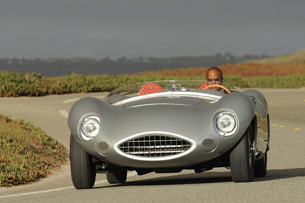
Rizk will be building no more than 40 of his vintage models, priced at $180,000 U.S. or 128,000 euros. The price doesn't change no matter which engine you choose. Said Rizk, "They're only a couple thousand dollars apart in price." As with any such bauble, you can have it customized any way you wish, and you can even get any engine you want; if you want to stick with the Aston theme and prefer Aston's V12 from the DBS, Rizk will engineer the appropriate exhaust manifold and you'll run with the fastest dogs around. That, however, we'd expect to cost a little more...
But everything you've read so far isn't even the best part of this story.
Rizk came to America from Egypt and spent four years and $750,000 – personally funded – to build the RA.
Yet perhaps the most compelling thing about the RA is that it's not the car Rizk came to America to build.

When we got in to drive and asked him to explain the genesis of the RA, he began talking about supercars and car design and the Nissan GT-R. We had no idea why he was talking about modern monsters, so we asked what the GT-R had to do with this modern retro masterpiece we were riding in. He said "Oh," as if we hadn't understood a thing.
Then he explained, "This car, the RA, is practice. I'm using it to learn about the things I want to do on the car I really came here to build, the next car."
Which means that Rizk essentially spent three quarters of a million dollars to construct a car builder's exercise book, and it just happens to look like the RA.
We won't even get into what he has in mind for his next car, because we're still completely taken with the RA. But if the RA is what he calls practice, we'll be the first to admit we can't wait to see what comes next.


Sign in to post
Please sign in to leave a comment.
Continue